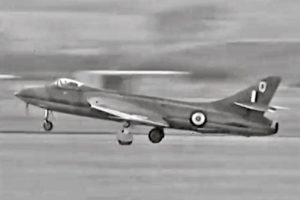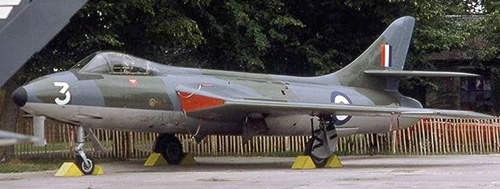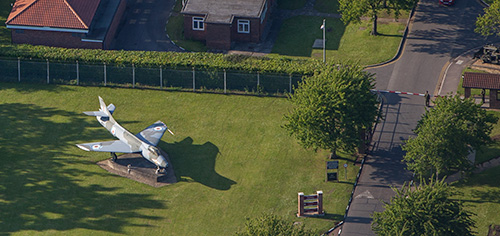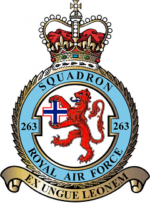
Our Hunter was built by Armstrong-Whitworths at Coventry under contract No.6/6315/CB.5b (later 7a) in 1953/54 and was the 17th F.Mk.2 to be produced (a total of 45 were built). At the time of ordering she was expected to cost the country approximately £50,000. Essentially similar to the Hunter F.Mk.1, the F.2 was powered by an Armstrong-Siddeley Sapphire engine rather than the Rolls-Royce Avon used by the F.1. This gave it superior performance to the F.1 (5 knots faster at 45,000 ft and taking 2.5 minutes less to get there; also a higher ceiling than the F.1). It also exhibited fewer problems than the Avon-engined F.1.
 WN904 was first flown on 27th July 1954, being delivered to the RAF’s 257 (Burma) Squadron on 13th September 1954. As with just about any defence contract, it seems, her price had gone up considerably since the placing of the original contract – her cost to the nation was £102,000 – more than double the initial estimate. Soon given the tail code ‘Q’ for Queenie (also worn on her nose gear door), she did not, however, have time to get full squadron markings applied as her service career was a very short one (even shorter than most F.2s).
WN904 was first flown on 27th July 1954, being delivered to the RAF’s 257 (Burma) Squadron on 13th September 1954. As with just about any defence contract, it seems, her price had gone up considerably since the placing of the original contract – her cost to the nation was £102,000 – more than double the initial estimate. Soon given the tail code ‘Q’ for Queenie (also worn on her nose gear door), she did not, however, have time to get full squadron markings applied as her service career was a very short one (even shorter than most F.2s).

257 Squadron was not fully equipped with Hunter F.2s until February 1955, finally getting rid of the last of their Meteors. These early months of Hunter operations were blighted with bad weather and poor serviceability, with the jets not able to fire their guns due to various problems including excessive vibration and damage caused by ejected ammunition links tumbling along the fuselage underside.

The remainder of 1955 proceeded fairly smoothly for WN904 which was lucky to avoid the more serious problems experienced by some of her sister ships. Her run of good luck, however, did not last. In January 1956 she was declared as Cat 4 – damaged, requiring special facilities or equipment and return to the manufacturer or a contractor for repair. Judging by the only reportable incident in the RAF Wattisham Operational Record Book that involved damage to a 257 Squadron aircraft that month, this is because the aircraft carried out an emergency landing on the short runway at RAF Kenley while running low on fuel enroute to RAF Biggin Hill – going through two hedges and over a public road in the process!
Repairs were carried out by the Gloster Aircraft Company but with the improved Hunter F.4 and F.5 in production, the RAF simply didn’t need their small number of F.2s any more. 257 Squadron had already begun converting to the F.5 when WN904 was damaged, and they were disbanded with very little warning at the end of March 1957, before WN904 had a chance to be returned to them. The repaired WN904 was therefore struck off charge on 22nd November 1957 and became a ground instructional airframe, 7544M. 257 Squadron had only received clearance for air to air gun firing after WN904’s mishap so it is likely that our Hunter never got a chance to fire her guns.

She was then transported to No.12 School of Technical Training at RAF Melksham and by 1959 had moved to No.9 SoTT at RAF Newton. In 1974 her ground instructional duties came to an end and she was donated to the Imperial War Museum at their then-new facility at Duxford. She was put on display there, still wearing the rather anonymous ‘3’ marking she had gained while a ground instructional airframe. While her flying career was short, her ground training career was long enough to make her probably one of the better value Hunter F.Mk.2s to be produced!
In 1989 WN904 was repainted in a dual scheme showing off the markings of 1 and 56 Squadrons and loaned to the Army to become a gate guard at Waterbeach Barracks (a former RAF station, where later marks of Hunter were flown from). Both 1 and 56 Squadrons operated Hunters from Waterbeach, though not the F.2 version, and of course WN904 never flew with either squadron.

She returned to Duxford in 1998 for a refurbishment as she was looking pretty tired, and had her existing faded paint stripped off before a complete repaint was carried out.

The aircraft returned to Waterbeach’s gate in 1999, with a new set of specially manufactured intake and exhaust blanks to replace the authentic items previously fitted which had long since “disappeared”. The markings were as before – dual 1 and 56 Squadron colours.

In July 2011 the MoD announced that Waterbeach Barracks would close by 2015, with the based units moving elsewhere. By November it was clear that 39 Engineer Regiment (Air Support) would move from Waterbeach to Kinloss in the summer of 2012, and HQ 12 (Air Support) Engineer Group would move from Waterbeach to RAF Wittering in the summer of 2013. WN904 was to become surplus to requirements, as she had no particular relevance to the departing Army units, or to Kinloss or Wittering.
Upon learning that the aircraft was possibly up for disposal, Sywell Aviation Museum put in a bid to give her a new home. In late July 2012, we learned that we had been successful, and arrangements were put in place to dismantle WN904 and transport her to Sywell, which was carried out on the 2nd of August. The move went smoothly and WN904 was reassembled the same day outside the Museum building on the edge of Sywell Aerodrome.
Thirteen years of exterior display had done WN904 no favours and her paint had faded once more and there had been a considerable build-up of dirt, moss and even lichen. However, IWM Duxford had done a good job back in 1998 and under the muck the airframe has been found to be very sound – with minimal corrosion. The all-important wing spars are in excellent condition with just a little surface pitting around the attachment pin points. Inside the various access panels she was remarkably complete and in good condition. The paint was very thin in places and the roundels had suffered particularly badly.
A couple of weeks intensive work on the aircraft including a thorough cleaning and polishing and the application of new roundels and fin flashes in vinyl (courtesy Sprint Graphics) had her looking much better just in time for the 2012 Sywell Jubilee Airshow where she was much admired.
She has no engine or guns, and we have already found some evidence of the damage that grounded her in 1956 – many of the lower nose panels are from another damaged aircraft (WN901), which backs up the theory that she suffered a landing incident at RAF Kenley. The cockpit was pretty complete, with only a few instruments and control units missing and she has a mostly intact ejection seat and joystick. There has been some moisture ingress, with some of the ‘shelf’ panels in the cockpit hiding small swimming pools. Single-seat Hunters are notorious for the cockpits leaking like sieves so we consider the relatively minimal amount of water in our jet a remarkable stroke of luck! Most of the damage has been caused to the more delicate items like switches, which have been easy enough to replace.
Work began in 2013 on returning the cockpit to a complete and accurate representation of how the aircraft would have looked when it was in service with 257 Squadron and was mostly completed by 2015. We do not intend to apply electrical power given the rarity of this airframe, but hopefully in the future we will have an isolated battery-powered circuit to illuminate the cockpit in a suitably authentic style for special occasions. The ejection seat was restored in 2017/2018 and put back in the aircraft, and a repaint was then begun with our good buddy Steve at Air Leasing spraying her in authentic camo colours during a very hot and dusty summer. Winter then intervened so work had to be put on hold…
 In 2018 we were also contacted by Mary-Anne Andrews, the daughter of a pilot lost in a Hunter F.Mk.2 of 257’s sister squadron at Wattisham – 263 Squadron. On 6th March 1956, Flying Officer Dennis Whiteman took off from RAF Wattisham on a routine night time cross country training flight in Hawker Hunter F.2 WN921 of 263 Sqn. His route was to take him via various light houses on the coast on a ’round robin’, returning to Wattisham within an hour or so. Sadly, he never returned; no distress calls were heard and no wreckage was ever found. He was just 23 years old. It is likely that his jet crashed into the sea, but we will likely never know. Mary-Anne’s story moved us to hatch a cunning plan – we would keep up the tradition of dual squadron markings on WN904 by marking her up on one side as WN921 / ‘S – Sugar’ – her father’s jet – so that she would be a 263 Squadron airframe on one side, and 257 on the other.
In 2018 we were also contacted by Mary-Anne Andrews, the daughter of a pilot lost in a Hunter F.Mk.2 of 257’s sister squadron at Wattisham – 263 Squadron. On 6th March 1956, Flying Officer Dennis Whiteman took off from RAF Wattisham on a routine night time cross country training flight in Hawker Hunter F.2 WN921 of 263 Sqn. His route was to take him via various light houses on the coast on a ’round robin’, returning to Wattisham within an hour or so. Sadly, he never returned; no distress calls were heard and no wreckage was ever found. He was just 23 years old. It is likely that his jet crashed into the sea, but we will likely never know. Mary-Anne’s story moved us to hatch a cunning plan – we would keep up the tradition of dual squadron markings on WN904 by marking her up on one side as WN921 / ‘S – Sugar’ – her father’s jet – so that she would be a 263 Squadron airframe on one side, and 257 on the other.
Design of the various small stencil markings and large squadron markings were carried out by museum member Damien Burke for production by Ollie at Sprint Graphics once more, and the aircraft was unveiled in her new combined colours at the Museum’s Easter opening in April 2019.
An unveiling ceremony included dedication of the aircraft as a memorial to Flying Officer Whiteman in particular, but also to all the men of 257 and 263 Squadron and all aircrew lost in RAF Hunters.

Since then, we felt that the – historically accurate – ‘blank’ side of WN904 looked a bit lacking in comparison to her WN921 side, which had colourful squadron markings. We had also been contacted by Geoff Millward, the brother of the late Squadron Leader ‘Dickie’ Millward AFC, a 257 (and 263) Squadron veteran, who was keen to see ‘Queenie’ wear full squadron markings. Dickie had quite the career, joining the RAF in late 1952, performing superbly in training and being selected to fly the then-cutting-edge Hunter with 257 and 263 Squadrons at RAF Wattisham. He went on to fly Hunters with 4 Sqn from RAF Jever, then an exchange tour flying F-86 Sabres with the Luftwaffe’s JG71 (providing fighter tactics advice to no less than Erich Hartmann, the highest scoring fighter ace of all time).
Dickie returned to the UK in 1962 to a Fighter Development post flying Hunter, Lightning and Javelin fighters for a short while before he was selected to attend the French Test Pilots School at Istres in Provence, the first English pilot to do so. On graduation from Istres, he was posted to Aero Flight at RAE Bedford. It was from here that he was able to fly the Fairey Delta 2, BAC 221, Shorts SC1, Handley-Page HP115 and numerous other experimental aircraft. He also managed to demonstrate many vintage aircraft of the Shuttleworth Collection – here he specialised, as ever, in fighters – SE5a, Bristol Fighter, etc. He was promoted to Squadron Leader in Command of Aero Flight and was awarded the Air Force Cross whilst at Bedford, and retired from the RAF in 1970, going on to a varied career in civilian flying until a crash in 1983 and resulting injuries grounded him. Dickie passed away in 1987 at the young age of 54.
So, whilst we do not have any evidence that WN904 ever wore her squadron colours whilst in service, we now had a fine excuse to apply some! Accordingly, in early May we applied the later style of 257 Squadron markings to WN904’s nose – green and yellow checks surrounding a Burmese Chinthe (temple guardian). This is both to commemorate Dickie Millward and his old Squadron but also to add a welcome splash of colour to even up our jet’s split personality! It is certain that, had she remained in service with the squadron, she would have gained these colours later in 1956 anyway. So, when Geoff visited us again on 9th May 2019 we had a surprise in store for him – see the above photo!
If you served on 257 or 263 Squadrons when they operated Hunters, we’d love to hear from you!
You can follow the restoration efforts on Facebook, in this photo album.




































